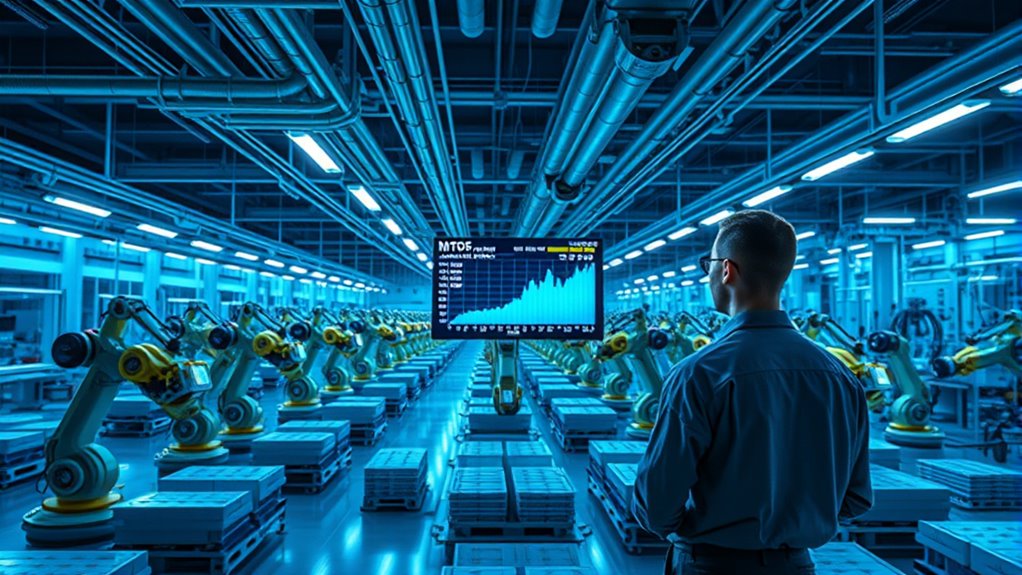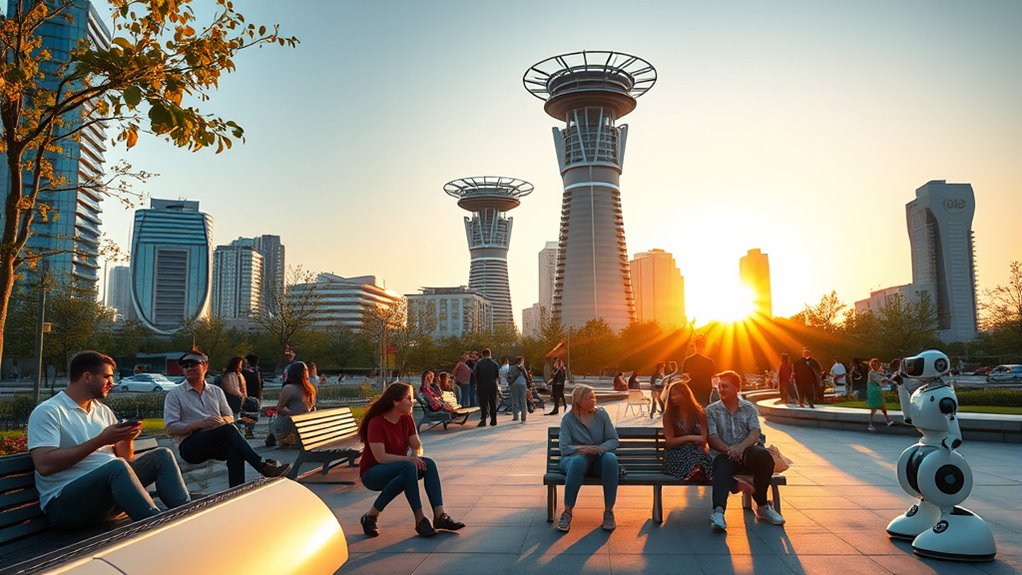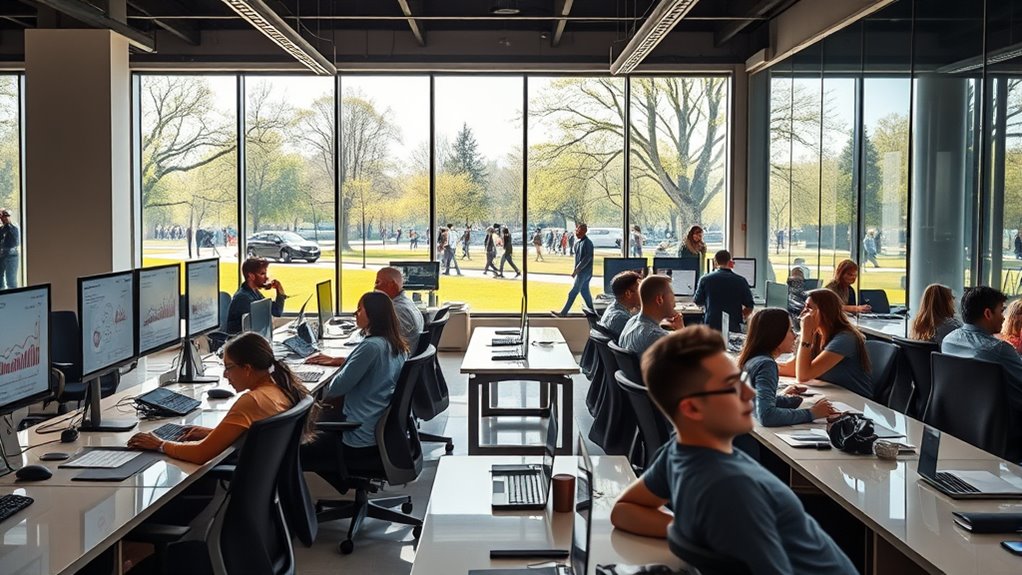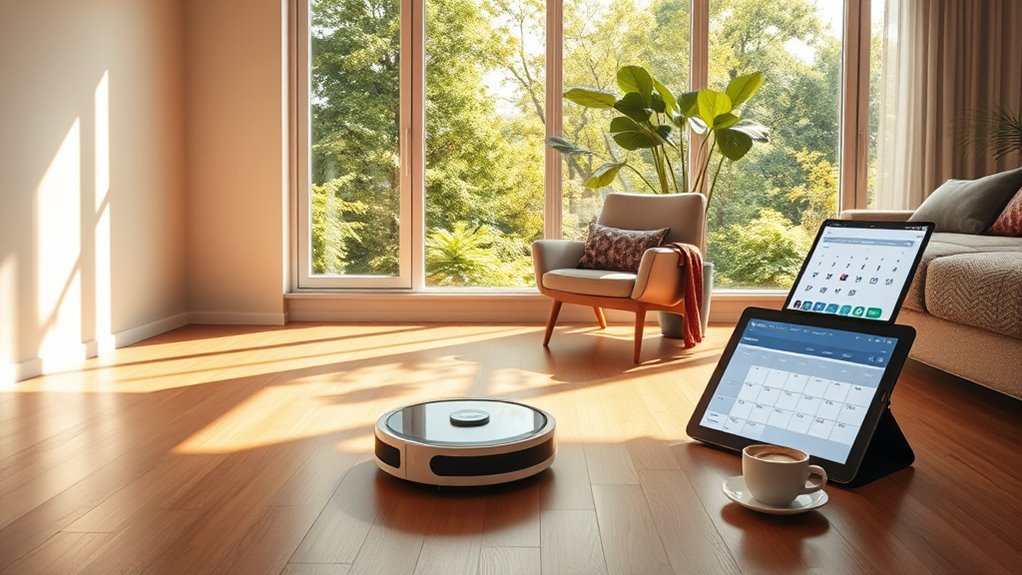Automation promises more leisure by making work faster and easier, but in reality, it often leads to longer hours and higher stress. Employers may extend workdays to boost productivity or save costs, while societal pressures and economic incentives push you to work more, not less. Although automation has potential benefits, it doesn’t automatically mean you’ll get extra free time. To understand how these trends really unfold, keep exploring what the experts are saying.
Key Takeaways
- Automation can reduce work hours by up to 360 hours annually, but many workers face extended workdays due to job displacement fears.
- Increased automation may lead to longer working hours to compensate for job insecurity and higher productivity demands.
- While automation frees time for certain tasks, ongoing oversight and training requirements can limit leisure gains.
- Economic and social factors, such as job displacement and inequality, can reduce access to leisure opportunities despite automation advances.
- The net impact on leisure time depends on balancing automation’s efficiency benefits with employment stability and societal adjustments.
The Promise of Increased Efficiency Through Automation

Automation holds great promise for boosting efficiency across industries, with nearly half of today’s work activities already capable of being automated using current technology. You can leverage automation tools to handle repetitive tasks, freeing up time for more complex and strategic work. Over half of all automation efforts focus on improving efficiency, and 78% of business leaders believe automation enhances productivity. Workers using automation report higher satisfaction, with 93% feeling more productive. Business process automation provides end-to-end visibility across systems, streamlining operations and reducing costs by 10–50%. Tasks like manual processing become faster and less error-prone, boosting quality and speed. Additionally, the integration of automation with existing systems can be optimized through workflow management, ensuring smoother transitions and better resource allocation. Moreover, adopting data-driven strategies can further refine automation efforts and maximize their impact. Implementing comprehensive automation frameworks can help organizations adapt to rapid technological changes and sustain long-term growth. As a result, automation drives operational efficiency, cuts expenses, and supports business growth, making industries more competitive and adaptable in today’s fast-paced environment. Nearly 50% of current work activities are automatable with existing technology, which underscores the potential for widespread efficiency gains. In addition, an understanding of nutritional content can help tailor automation solutions to specific industry needs and improve overall effectiveness. Furthermore, incorporating natural language processing enhances the ability of automation tools to interpret complex data and improve decision-making processes.
The Reality of Longer Workdays and Reduced Leisure

Although automation promises increased efficiency, it has also contributed to longer workdays and less leisure time for many workers. Instead of reducing hours, automation often shifts the workload or creates job insecurity, leading to stress and longer hours. For example:
- Up to 30% of work hours could be automated by 2030, causing job displacement and increased workload for some.
- Over a third of workers worry about losing jobs, which can push them to work longer hours to secure their positions.
- Automation could displace 15% of global work hours, reducing leisure opportunities. Additionally, the job market dynamics are constantly evolving as employers adapt to automation, further influencing work hours.
- Despite time savings estimates of 240-360 hours annually, many workers still face extended workdays due to job insecurity and shifting roles.
- The impact on employment remains uncertain, with some studies suggesting automation may create new roles that require longer working hours before adapting to the change.
Economic Incentives and the Shift Toward Extended Hours

Economic incentives strongly motivate firms to extend work hours, as they can increase productivity and reduce costs. Higher pay rates for overtime—often 1.5 to 2 times the regular wage—encourage workers to put in extra hours. Meanwhile, extending standard hours cuts down on expensive overtime, lowering overall labor costs. Spreading fixed labor costs over more hours boosts efficiency, and longer hours can lead to increased output through positive scale effects. Firms might also substitute labor for capital, reducing labor costs and potentially raising employment. Extending hours can increase total employment, reduce non-productive time, and maximize capital use, further driving productivity. These incentives align to promote longer working hours, even as automation advances and debates about leisure time grow. Additionally, breakfast delivery options are evolving to meet consumer demand for convenience, often requiring extended operational hours to serve customers early in the morning. The trend toward extended operating hours is also influenced by the need to adapt to global markets and maintain competitiveness. Furthermore, the pressure to maximize labor utilization can contribute to longer work hours despite technological advancements that could reduce the need for human labor. As organizations seek to optimize resource allocation, efficient scheduling becomes a crucial strategy to manage extended hours without compromising worker well-being.
Technological Advances Accelerating Automation and Its Impact

You’re witnessing rapid AI development that’s transforming multiple industries, speeding up automation adoption. This expansion means more tasks become automated, reducing manual work and boosting efficiency across sectors. As these advances accelerate, you’ll see automation increasingly shape how work and leisure intersect. Prevalence of automation tools in workflows is rising rapidly, with 70% of organizations set to adopt structured automation by 2025. Furthermore, the integration of AI-driven personalization technologies enhances user experiences and streamlines processes, further fueling the shift towards automation. As automation becomes more widespread, it also raises important concerns about job displacement and the need for workforce adaptation. Additionally, the surge in cybersecurity threats during outages underscores the importance of robust security measures to protect automated systems and data. The growing sophistication of automation technology highlights the necessity for ongoing innovation in security protocols to safeguard these systems. The continual improvement of machine learning algorithms plays a vital role in making automation more efficient and adaptive to changing environments.
Rapid AI Development
Have you noticed how rapidly AI technology is advancing and transforming industries? The global AI market is now worth about $391 billion, growing at nearly 36% annually. You’ll see AI adoption spreading fast—around 89% of small businesses have already integrated AI tools. Companies are investing more, with 58% planning to increase AI budgets by 2025, dedicating up to 20% of their tech spending. Generative AI, used by 51% of firms for content and automation, is leading the charge. Here’s what’s happening:
- Voice assistants will reach 8 billion by 2025, shifting how you interact with tech.
- The AI market is projected to grow at a CAGR of 28.46% through 2030.
- AI could add over $15 trillion to the global economy by 2030.
- It may create 133 million new jobs, transforming the workforce landscape.
Expanding Automation Sectors
Technological advances are rapidly accelerating the expansion of automation across various sectors, transforming how industries operate. In manufacturing, robotics now increase production speed and reduce errors, especially in inventory management. Healthcare relies on AI-powered systems for automated patient scheduling and predictive diagnostics, improving accuracy and efficiency. Retailers leverage AI-driven chatbots and smart inventory systems to enhance customer experiences while streamlining operations. Logistics benefit from automation by optimizing supply chains, streamlining processes, and improving order accuracy. Companies are also integrating adaptive technologies to boost operational performance across industries. Innovations like plug-and-produce solutions, vision technology, and advanced motion control are making automation more scalable, flexible, and easier to implement. As these sectors expand, automation’s role in reshaping industries becomes more profound, paving the way for increased efficiency and productivity. Additionally, the integration of cybersecurity measures ensures that automated systems remain secure from potential threats as reliance on technology grows. The ongoing development of AI-driven solutions continues to push the boundaries of what automation can achieve, and the incorporation of wave and wind energy sources into renewable automation processes is opening new sustainable pathways, fostering a future where many tasks may be fully automated, potentially freeing up human resources for more creative and complex roles. Moreover, the growing adoption of digital transformation strategies across industries highlights the shift towards intelligent automation and data-driven decision-making, which can further enhance operational efficiency. Furthermore, understanding the socio-economic impacts of automation helps prepare society for the shifts in employment and workforce dynamics that are likely to occur as automation becomes more pervasive.
Job Market Transformations and Shifts in Employment Patterns

The rise of automation and artificial intelligence is actively reshaping the job market, leading to significant shifts in employment patterns across industries. You’ll notice some roles, like customer service and medical transcription, face displacement. At the same time, new jobs are emerging, especially in fields related to AI implementation and management. To understand these shifts better:
- Automation improves efficiency but risks job displacement in sectors like banking and insurance.
- Growing demand for technological skills reflects changing job requirements.
- Industries such as software development and financial advising continue to grow, creating new opportunities.
- Technological advancements drive the emergence of roles focused on AI and robotics, while traditional roles adapt or decline.
- The evolving landscape underscores the importance of fostering digital literacy to prepare the workforce for future challenges. Additionally, understanding the hours of operation of various sectors, including retail and grocery stores, can influence workforce scheduling and economic planning.
- As these technological changes accelerate, training programs are increasingly vital to equip workers with the necessary skills for new roles. Furthermore, the development of robust safety measures, such as ongoing AI security monitoring, is essential to mitigate risks associated with AI deployment. Recognizing the need for continuous learning helps industries stay ahead in this rapidly changing environment.
These changes mean your skills need to evolve, and industries must adjust to maintain employment stability.
Societal Changes in Leisure and Social Engagement

As automation increases, you might notice fewer opportunities for face-to-face social activities, as people spend more time passively using screens. This shift can lead to decreased social engagement and feelings of isolation. At the same time, economic inequality could widen if benefits from AI aren’t shared fairly, impacting community cohesion and access to leisure. Developing cultural intelligence can help individuals and organizations navigate these social changes more effectively.
Reduced Social Activities
Automation’s rise has markedly altered how people engage socially, often reducing opportunities for face-to-face interaction and community participation. Job displacement and economic insecurity lead to social withdrawal and less involvement in traditional social activities. As job stability declines, you might find yourself less motivated or able to participate in community gatherings or cultural events. Consider these impacts:
- Reduced community spaces due to economic shifts, limiting social hubs.
- Lower disposable income, restricting spending on cultural and recreational activities.
- Automation replacing human interactions, decreasing face-to-face exchanges.
- Increased social isolation from job loss and underemployment, weakening social networks.
These changes can diminish your sense of belonging and community cohesion, making social activities less accessible and less frequent. The shift isn’t just economic; it deeply affects how society connects and shares leisure.
Shift to Screen Time
With fewer opportunities for face-to-face interaction and community involvement due to economic shifts and job displacement, many people now turn to screens for entertainment and connection. On average, you spend about 6 hours and 38 minutes daily on internet-connected devices, with over five hours on your phone alone. Screen time now accounts for roughly 40% of your waking hours, and since 2013, it’s increased by nearly half an hour daily. Most of this time is spent engaging with digital content, especially on social media, which influences how you interact socially. This shift affects your relationships and learning habits, as virtual interactions replace traditional face-to-face contact. As screens become central to daily life, your social behaviors and mental health are increasingly shaped by digital engagement.
Economic Inequality Effects
How does economic inequality shape the way you spend your leisure time and engage socially? If wealth is concentrated among capital owners, those with fewer resources may find their leisure options limited or unevenly distributed. Automation often benefits the wealthy through capital gains, widening disparities. This can lead to:
- Low-skilled workers facing stagnant wages and reduced social engagement due to job loss.
- High-skilled households experiencing more leisure time, but often choosing to work longer hours for income.
- Increased reliance on gig economy jobs for low-skilled workers, which may limit social interactions.
- Wealth gaps influencing access to community activities, creating social divides.
Ultimately, economic inequality can restrict your social participation, making leisure a privilege rather than a universal right, especially when financial stability determines engagement opportunities.
Balancing Productivity Gains With Personal Well-Being

Balancing the productivity gains from automation with personal well-being requires careful management, as increased efficiency can both improve job satisfaction and pose challenges to leisure time. Automation helps reduce repetitive tasks, giving you more room for strategic and creative work, which can boost your job satisfaction and mental health. As 90% of knowledge workers report better well-being, automation has the potential to enhance work-life balance. However, human oversight remains essential, and managing this can limit leisure gains. To truly benefit, you need to ensure automation is integrated smoothly, with proper training and support. While automation offers the promise of more leisure, balancing its advantages with personal well-being involves addressing limitations, ethical concerns, and the need for ongoing adaptation.
Frequently Asked Questions
Will Automation Necessarily Lead to More Free Time for Workers?
You might think automation will give you more free time, but it often leads to longer work hours instead. As AI boosts productivity, employers expect more output, and you may work extra hours to earn higher wages. While automation can reduce chores and unpaid work, many workers trade leisure for additional income or job security. So, automation doesn’t necessarily mean more free time for you right now.
How Does Increased Productivity Impact Workers’ Overall Well-Being?
You might think increased productivity boosts your overall well-being, but it’s not always the case. When automation speeds up work without reducing workload, you can feel more stressed and anxious. Continuous monitoring and fast-paced tasks can harm your safety and mental health. While automation can eliminate boring tasks, it may also threaten your job security and sense of purpose, ultimately impacting your well-being negatively.
Are There Differences in Automation’S Effects Across Various Industries?
You see, industry differences make automation’s effects quite the mixed bag. In healthcare and transportation, it replaces routine tasks, but in marketing or creative fields, it’s more about enhancing what you already do. So, instead of a one-size-fits-all outcome, some industries see longer work hours, while others find more time freed up. Ironically, technology’s promise of leisure often depends on where you work and how quickly your industry adopts automation.
What Policies Could Ensure Automation Benefits Leisure and Work-Life Balance?
To guarantee automation benefits your leisure and work-life balance, policies should promote flexible work arrangements like remote work and flexible hours. Encourage automation of routine tasks to free up your time and reduce stress. Support ongoing education so you can adapt to new technologies. Implement workplace regulations that fairly distribute automation benefits, monitor impacts regularly, and provide work-life balance programs. These steps help you enjoy more leisure while maintaining productivity.
How Might Automation Influence Future Societal Perceptions of Work and Leisure?
Automation will likely reshape how society views work and leisure. You might find that productivity gains lead people to value work more, pushing longer hours despite technological efficiencies. Leisure could become more passive and isolated, with less emphasis on social activities. As automation blurs work-life boundaries, you may see a cultural shift where earning and productivity take precedence over leisure, redefining what fulfillment and success mean in everyday life.
Conclusion
Automation promises more leisure, but it often leads to longer work hours and blurred boundaries. It challenges you to find balance between productivity and well-being, between efficiency and fulfillment. As technology advances, you must navigate shifts in jobs, society, and your own priorities. Ultimately, it’s up to you to shape a future where automation serves you—not the other way around—by choosing leisure, embracing change, and staying true to what truly matters.









